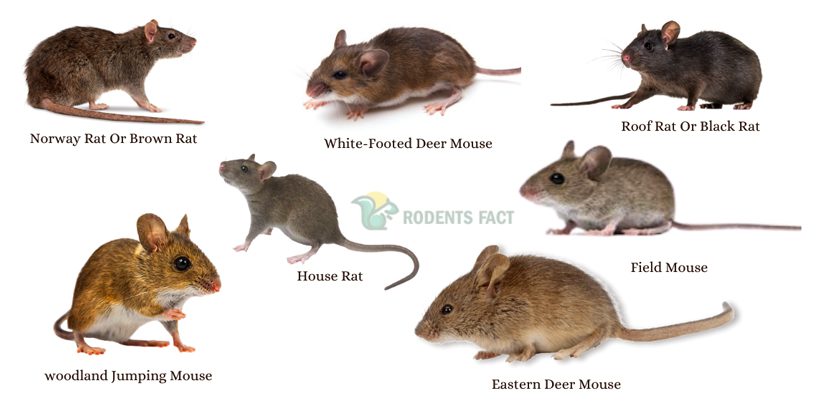7 Common Types Of Rats In Massachusetts
Every state has its unique problem. Massachusetts is a state with specific problems with rats. Here anyone can find different types of rats.
So, what are the common types of rats in Massachusetts? The most common type of rat in Massachusetts is the Norway rat. They are brown and their tails are shorter than their body. Roof rats are also common in Massachusetts. They have other names like black rats or ship rats. In the state house rats, field mice, white-footed, and eastern deer mice are spread in good amounts.
This is only the gist of this whole article. The basic information about the rats is given below. To know about the rats and mice in detail, go through the whole article.
7 Types Of Rats In Massachusetts
Many species of rodents are widely spread in the state of Massachusetts. Take a look at the common rats below:

Type 1: Norway Rat Or Brown Rat
Norway rats are most common in Massachusetts. This type of rat belongs to China. Through the transport system, they entered Massachusetts. Take a look at its common characteristics.

Other Name
- These rats are also called brown rats due to their appearance.
- They are commonly seen in the street area. So, people can also recognize this rat as a street rat.
- Sewer rat.
Habitat
Norway rats are not commonly seen in houses like black rats. Rather they prefer to live in the tunnels, drains, piles of trash, subways, or the area around the sewer. So, their other name is sewer rat.

Feeding Behavior
- They come out at night to find food. It is a way to hide themselves from predators.
- But if they come out during the daytime, it is a sign that they are increasing in number.
They live upon eating smaller animals, seeds, nuts, and other grains.
Disease Transmission Status
This type of rat has a lower transmission rate of dangerous diseases in comparison to other rats.
However, the diseases they transmit are also highly infectious and difficult to cure. Norway rats can transmit diseases like influenza A, rat bite fever, and jaundice.
Special Information
Though they harm in many ways, people can still make money by using them. Like the white rats, people keep Norway rats as pets. So, the breeders sell this type of rat and their subtype and earn a good amount.
Type 2: Roof Rat Or Black Rat
After Norway rats, roof rats are the largest number in Massachusetts. They are featured with a longer tail than their body with big ears. Black rats mainly come from India.

Other Name
- These rats are filled with black fur. So they can be called black rats.
- People also know these rats as ship rats.
Habitat
Their reproductive rate is slower than Norway rats. So they have less chance of overgrowth. Like Norway rats, these rats do not like to live beside watery places or sewage. Rather you can see them in high-up places.
They prefer to live on the roofs of houses. They take the help of pipes or tree branches to reach a high-up place.
Through any small hole, they enter and choose a safe living place.
Feeding Behavior
They eat fruits, leftover foods, nuts, and veggies.
Disease Transmission Status
Black rats also carry many infectious diseases. Bubonic plague, salmonella, and typhus are common. They can infect people with these infections while searching for food in the house.
Special Information
These rats are less likely to be kept as a pet. Because if they get to a safe place, they will gather other black rats and will keep multiplying. The impact of black rats in any place is not pleasant.
Type 3: House Rat
Most of the cases of rat problems arise due to house rats. They are commonly seen in every house at least one time a year.

Habitat
They built their nest in piles of clothes, cartoons, or narrow holes. Dirty rooms are their favorite place and suitable for their living.
Feeding Behavior
They mainly eat leftover food or uncovered foods. They do not prefer living outside due to insufficiency of food. In case they are living outside, they attack each other when food is insufficient.
Special Information
- They adjust themself to live around humans.
- As they get plenty of food and less chance of predators, they start living in the houses.
- House rats hide themself most of the time.
- They come out and search for food while the surroundings are dark.
Type 4: White-Footed Deer Mouse
White-footed deer mice are also common in Massachusetts. These mice belong to North America.

Habitat
They prefer to build nests in areas where human gathering is less. But they can be found on trees, the ground floor of houses, and unused bird nests.
Disease Transmission Status
These mice act as carriers of many diseases. The virus and parasite they carry do not harm them or lightly harm them. But if it infects humans it can cause serious disease. Lyme disease is an uncommon disease that is transmitted by this mouse. Hantavirus is also transmitted by white-footed deer mice which can cause severe respiratory disease in humans.
Type 5: Eastern Deer Mouse
Eastern Deer Mice are seen both in houses and outside. These mice are common in Massachusetts and hard to get rid of. These mice are similar to white-footed mice and also belong to North America.

Habitat
Mostly these mice prefer to build nests in high-up places like trees. They can live upon food crumbs. Their reproduction rate is high. So, if they get a safe place, they can grow at a high speed.
Type 6: Field Mouse
Field mice are not common in houses.

Habitat
They live around the field areas where food is available. They built their nests in a way to hide them with the help of grasses. They avoid crowded or populated areas.
Feeding Behavior
This type of mouse can even live on grasses, plants, and flowers. They also eat smaller animals, leftover foods, veggies, and fruits.
Special Information
- Field mice or Meadow mice are often seen to be prey. As they search for food in the daytime, they get targeted by cats, snakes, and birds. So, they never overgrow.
- They can not be kept as pets.
Type 7: Jumping Mouse
Jumping mice are less common in Massachusetts than other rats and mice described above.

Habitat
These mice are not seen in the houses. They avoid crowded areas. Mostly you can find this type of mouse around or under rocks and roots of big trees.
Special Information
- They are more active during summer and are aggressive.
- They have a hibernating nature and store food in their body as fat.
- These mice can not be kept as pets due to their aggressive and wild nature.
These are all the commonest and most widely seen rats in Massachusetts. All of them can be spread both indoors and outdoors.
How To Get Rid From Rats And Mice?

- To avoid the excessive occurrence and disturbance of these rats, you can take the help of pest control products. Or there are natural repellents available that discourage rodents from staying.
- Seal all the holes and leakage.
- Maintain daily cleanliness.
- Trim the branches of trees that are attached to your house.
- Adopting a pet cat can also help you to get rid of mice.
- Use a mouse trap.
Watch this video to get an idea about suitable mouse traps.
FAQs
These are some commonly asked questions by people about rats in Massachusetts.
Q: Are pet house rats harmless?
The pet house rats are not fully harmless. However, the rate of spreading infectious disease is lower in pet rats than in wild rats. Parasites and pathogens can still live in your pet’s body without affecting them. So, the rat owners should always maintain hygiene.
Q: How common are rats in Massachusetts?
The record says that their number has been increasing in the last few years. Boston, a city in Massachusetts, ranked 13th in terms of having rats.
Q: What is Massachusetts doing about the rat problem?
Some cities in Massachusetts have taken steps to control rats. Rat infection has created many health issues there. So they have started collecting data about killing rats. In some cities, smart boxes are given to electrocute, kill, and count the killing number.
Conclusion
Many rat infestations in Massachusetts. Among all the rats, brown rats, black rats, and house rats are common. Jumping mice are not commonly seen. But that does not mean they are present in a small amount. The field mice are commonly seen in the field. They are more common than white-footed deer and eastern deer mice.
Among all these rats and mice, some are kept as pets. Some can enter the house and cause diseases. To get rid of these unwanted guests, the household in Massachusetts should call pest control once a year.




